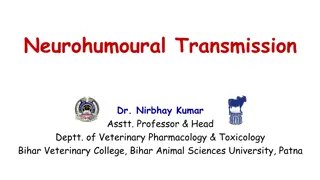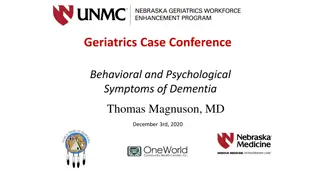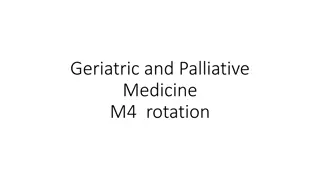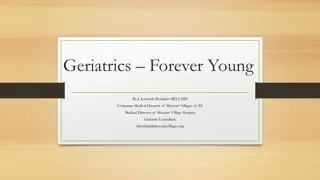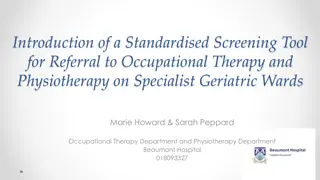Understanding Hospital Utilization Patterns Among Older Adults in Toronto
Exploring the hospital utilization trends in the geriatric population in Toronto, this content showcases the impact of aging on healthcare services. It highlights the prevalence of hospital visits, admissions, and types of care received by seniors aged 65 and above. The data presented underscores th
4 views • 69 slides
Understanding Pharmacokinetics in Clinical Pharmacology
Pharmacokinetics, as explained in a lecture by Oula Mohammed Sami, M.B.Ch.B/MSc in clinical pharmacology, delves into how the body processes drugs, contrasting with pharmacodynamics which focuses on drug actions. Key topics covered include properties influencing treatment outcomes, the significance
6 views • 45 slides
Historical Development and Principles of Pharmacology
Explore the historical roots of pharmacology from ancient civilizations like India, China, and Egypt. Learn about the development and principles of drug activity, including pharmacokinetics and pharmacodynamics. Discover early medicinal practices and the evolution of drug administration. Gain insigh
2 views • 50 slides
Optimizing Geriatric Pharmacotherapy: Challenges and Considerations
This content elaborates on the Nebraska Geriatrics Workforce Enhancement Program, supported by HRSA, focusing on age-friendly primary care and the 4Ms approach to medication management in older adults. It addresses the objectives of understanding factors affecting drug use in the elderly, recognizin
1 views • 42 slides
Overview of Sedatives and Hypnotics in Veterinary Pharmacology
This chapter discusses the classification, salient features, and uses of sedatives and hypnotics in veterinary pharmacology. Sedatives subdue excitement and induce calmness without necessarily causing sleep, while hypnotics induce and maintain sleep. Both classes of drugs act as CNS depressants and
1 views • 23 slides
Pharmacology of the Autonomic Nervous System Part 2 Summary and Learning Objectives
Explore the pharmacology of the autonomic nervous system focusing on cholinergic and adrenergic agents. Learn about cholinomimetics, direct and indirect acting cholinergic agonists, their therapeutic indications, and adverse effects. Discover the mechanism of action and uses of nicotinic agonists. D
1 views • 44 slides
Renal Pharmacology: Drug Excretion and Renal Clearance Questions
This comprehensive set of questions and answers covers topics related to drug excretion and renal pharmacology. It includes information on glomerular filtration, drug excretion mechanisms, dosage adjustments in renal impairment, factors influencing drug excretion, and the effects of long-term NSAID
0 views • 55 slides
Overview of Cephalosporins in Veterinary Pharmacology
Cephalosporins are a group of semisynthetic antibiotics derived from cephalosporin C obtained from a fungus. This chapter covers the introduction, chemistry, properties, solubility, classification, spectrum of activity, mechanism of action, applications, and side effects of cephalosporins. They offe
2 views • 29 slides
Understanding Pharmacology of Corticosteroids by Dr. Saeed Ahmed
Corticosteroids are steroid hormones produced by the adrenal cortex, classified into glucocorticoids and mineralocorticoids. Glucocorticoids have diverse effects on metabolism, immune responses, and inflammation, whereas mineralocorticoids regulate electrolyte balance. Mechanistically, corticosteroi
1 views • 32 slides
Understanding Routes of Drug Administration in Fish Pharmacology
Fish pharmacology is crucial for treating fish diseases effectively using drugs. Factors like water quality, pathogens, mortality rate, legal aspects, and economics need consideration. Different routes of drug administration in fish include water medication, immersion or dipping, hyperosmotic infilt
1 views • 20 slides
Comprehensive Guide to Geriatric Medication Management
Explore the essentials of geriatric pharmacology, including the impact of polypharmacy, medication-related problems in the elderly, and practical factors affecting medication management. Learn about medication reconciliation, Beers criteria, and common medications affecting seniors' health and well-
0 views • 25 slides
Understanding Neurohumoural Transmission in Veterinary Pharmacology
Neurohumoural transmission in the field of veterinary pharmacology involves the communication of nerve messages through the release of chemical messengers. This process includes axonal conduction and junctional transmission. The historical aspects of neurohumoural transmission highlight key discover
5 views • 11 slides
Enhancing Care Coordination for Older Adults with Frailty: A Competency Framework Approach
Addressing the challenges in coordinating care for older individuals living with frailty, this initiative focuses on implementing a competency framework to improve interprofessional practice in Ontario. The project aims to enhance geriatric assessment skills, promote a primary geriatric assessor mod
1 views • 52 slides
Understanding Cholinergic Neurons and Agonists in Pharmacology
Cholinergic neurons play a vital role in neurotransmission by utilizing acetylcholine (ACh) as a neurotransmitter. This neurotransmission involves steps like synthesis, storage in vesicles, release, receptor binding, degradation, and recycling of choline and acetate. Choline acetyltransferase cataly
0 views • 30 slides
History and Use of Penicillins in Veterinary Pharmacology
Penicillins, the first beta-lactam drugs discovered by Alexander Fleming, play a crucial role in combating bacterial infections. With a rich history dating back to 1928, these antibiotics revolutionized healthcare during World War II, significantly reducing mortality rates from infectious diseases.
0 views • 18 slides
Overview of Non-Steroidal Anti-Inflammatory Drugs (NSAIDs) in Veterinary Pharmacology
Non-steroidal anti-inflammatory drugs (NSAIDs) are a diverse group of medications with analgesic, anti-inflammatory, and antipyretic effects. They act primarily on peripheral pain mechanisms and have limited CNS effects. NSAIDs have a long history dating back to the use of White Willow bark, and the
0 views • 16 slides
Understanding Geriatric Rehabilitation and Disability Models
Acute medical illnesses can lead to functional decline in elderly individuals, requiring comprehensive geriatric assessments and rehabilitation. This involves addressing factors like frailty, comorbidities, and social/environmental barriers. Disability is viewed through both medical and social model
0 views • 34 slides
Understanding Respiratory System Pharmacology and Cough Physiology
The regulation of respiration involves sensory and efferent pathways, with afferent pathways comprising stretch receptors, C-fibres, and irritant receptors, while efferent pathways include parasympathetic and sympathetic nerves. Cough physiology is a protective reflex initiated by various stimuli to
2 views • 43 slides
Pharmacology of Ovulation-Inducing Drugs
Understanding the mechanism of ovulation and hormonal regulation is key in classifying drugs used to induce ovulation. This lecture covers the pharmacology of different groups of drugs, their mechanisms of action, administration protocols, indications, efficacy rates, and adverse effects. Antiestrog
0 views • 6 slides
University of Aberdeen Geriatric Assessment Audit Report
The University of Aberdeen conducted an audit focusing on comprehensive geriatric assessment in acute settings, looking at the multidisciplinary team's composition and its impact on patient care. Data was collected on admission routes, staff involved in CGA, access to various services, and how the d
0 views • 41 slides
Understanding the Parasympathetic Nervous System and Cholinergic Pharmacology
Dive into the world of the parasympathetic nervous system and cholinergic pharmacology, exploring concepts like cholinomimetics, parasympathomimetics, cholinolytics, and more. Discover how acetylcholine synthesis and degradation play crucial roles in these processes, and learn about different cholin
1 views • 27 slides
Understanding ELISA Techniques in Cellular and Molecular Pharmacology
ELISA (Enzyme-Linked Immunosorbent Assay) is a vital immunological technique used in detecting antigens or antibodies in samples. This article covers the types of ELISA tests, such as Direct, Indirect, and Sandwich, along with the principles and applications of ELISA in diagnosis. The process involv
0 views • 18 slides
Ambulatory, Pediatric, and Geriatric Surgical Considerations
This content discusses ambulatory, pediatric, and geriatric surgery considerations, outlining the differences in surgeries for different age groups. It covers aspects such as prime candidates for ambulatory surgery, procedures done in ambulatory surgical centers (ASCs), staffing considerations, and
0 views • 32 slides
Student Perspectives on Learning Pathology and Pharmacology in Veterinary Medicine
Explore student experiences in learning tricky concepts in pathology and pharmacology as part of a veterinary medicine program. Discover challenges faced, valuable resources created, and the importance of student perspectives in enhancing learning outcomes.
0 views • 21 slides
Understanding Pharmacology and Toxicology in Investigator Brochures
Explore the essential aspects of pharmacology and toxicology covered in Investigator Brochures, including nonclinical information, safety pharmacology, general toxicology, genetic toxicology, and more. Learn about the significance of pharmacology in predicting intended and unintended effects, consid
1 views • 40 slides
Pediatric Pharmacology Considerations and Challenges
Developmental pharmacology in children involves unique considerations such as drug metabolism, urine concentration, and muscle relaxant dosing. The field faces challenges with limited drug testing in pediatric populations, emphasizing the importance of age-appropriate pharmacotherapy. Factors like d
0 views • 39 slides
Understanding Behavioral Symptoms of Dementia in Geriatric Patients
This informational content discusses the various behavioral and psychological symptoms of dementia (BPSD) in geriatric patients, including common symptoms like depression, aggression, anxiety, and apathy. It highlights the prevalence of behavioral issues in dementia patients, their impact on caregiv
0 views • 15 slides
Understanding Ocular Pharmacology: General Principles and Drug Delivery
The study of ocular pharmacology involves understanding general pharmacological principles, pharmacodynamics, and pharmacokinetics. Drugs can be delivered to ocular tissue locally via eye drops, ointments, injections, or systemically through oral or intravenous routes. Factors such as drug concentra
0 views • 58 slides
Comprehensive Geriatrics and Palliative Medicine M4 Rotation Program Overview
This program offers a 4-week rotation in Geriatric and Palliative Medicine across Memphis, Knoxville, and Chattanooga. Students engage in various clinical settings, including inpatient palliative care, geriatrics, home visits, hospice settings, and specialty clinics. Didactics cover Narrative Medici
0 views • 6 slides
Origins and Growth of Geriatrics Specialty in the USA
Origins and development of the specialty of Geriatrics in the USA are traced from the pioneering work of Dr. Ignatz Leo Nascher to the establishment of the American Geriatric Society in 1942. Key milestones include the creation of Geriatric fellowships, the role of organizations like the AAFP in rec
0 views • 28 slides
Pharmacology of Heart Failure with Reduced Ejection Fraction (HFrEF)
Understanding the pharmacology of heart failure with reduced ejection fraction is crucial as it impacts millions of Americans and poses significant healthcare costs. The complex pathophysiology involves mechanisms like the Frank-Starling mechanism, alterations in myocyte regeneration, neurohumoral s
0 views • 44 slides
Understanding Ocular Pharmacology - An Overview by Dr. Ajai Agrawal
Explore the intricate world of ocular pharmacology with Dr. Ajai Agrawal, an Additional Professor at A.I.I.M.S., Rishikesh. The learning objectives cover pharmacokinetics, pharmacodynamics, and various routes of drug administration in ocular treatments. Delve into the anatomy of the eye, tear film c
0 views • 51 slides
Understanding Aging and Geriatric Medicine in Traditional Chinese Veterinary Medicine
As animals age, their organ functions decline according to Traditional Chinese Veterinary Medicine principles. The liver, heart, spleen, lung, and kidney are affected at different stages, leading to various health issues such as weakness, cognition decline, and incontinence. Recognizing signs of agi
0 views • 25 slides
Implementation of a Standardized Screening Tool for Referral to Occupational Therapy and Physiotherapy on Specialist Geriatric Wards
Occupational therapists and physiotherapists at Specialist Geriatric Wards implemented a standardized screening tool using a triage sticker to improve efficiency in therapy referrals for frail older adults. Through a Quality Improvement initiative, the triage sticker with set criteria identified pat
0 views • 4 slides
Exploring the Fascinating World of Pharmacology: From Historical Developments to Basic Principles
Uncover the rich history of pharmacology from ancient civilizations to modern times, tracing the origins of medicinal practices and the development of drug-related concepts. Delve into the fundamental areas of pharmacology, including pharmacokinetics and pharmacodynamics, to understand the mechanism
0 views • 50 slides
Pharmacology Lab Equipment and Safety Guidelines
Explore the setup and procedures of a Pharmacology lab focusing on agonists and antagonists potency testing. Learn about equipment, tissue suspension, lab safety, lab plan, and health precautions. Follow instructions for conducting experiments, recording data, and cleaning up. Utilize resources prov
0 views • 28 slides
Understanding ADME in Pharmacokinetics and Pharmacology
Pharmacokinetics and pharmacology, focused on ADME processes, play a crucial role in drug development and delivery. Absorption, distribution, metabolism, and excretion determine how drugs interact within the body. Absorption involves transfer into the bloodstream, while distribution entails the spre
0 views • 12 slides
Overview of Psychiatric Pharmacology: A Comprehensive Guide from 2013
This presentation delves into the nuances of psychiatric pharmacology, exploring common psychiatric conditions, historical perspectives on medical treatments, categories of psychiatric medications, and principles of treatment. It also touches on mental illness definitions from DSM-IV-TR and DSM-V, a
0 views • 27 slides
Comprehensive Geriatric Assessment: Enhancing Care for Older Adults
The field of geriatrics focuses on the unique healthcare needs of older adults. Geriatric assessment involves a multidimensional approach to evaluate medical, psychological, social, and functional aspects of elderly individuals. By utilizing specific tools to assess various dimensions, including cog
0 views • 49 slides
Geriatric Anaesthesia: A Guide to Perioperative Care for Elderly Patients
The field of geriatric anaesthesia addresses the unique challenges faced by elderly patients undergoing surgery, including higher perioperative complication rates due to reduced functional reserve and co-morbidities. This guide emphasizes the importance of careful preoperative assessment, meticulous
0 views • 25 slides











